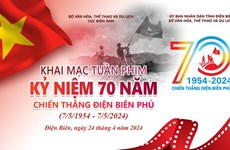Then singing seeks inscription on world heritage list
The northern province of Tuyen Quang is taking steps to have the
traditional Then singing of the Tay ethnic group be included on the
list of the world intangible cultural heritage of humanity.
The northern province of Tuyen Quang is taking steps to have the
traditional Then singing of the Tay ethnic group be included on the
list of the world intangible cultural heritage of humanity.
Local authorities have worked with the Vietnam National Academy of Music and other northern provinces of Cao Bang, Lang Son, Bac Kan, Thai Nguyen, Lao Cai, Lai Chau and Bac Giang – where the music is practised, to compile a dossier seeking the UNESCO’s title in 2015.
The province has designed plans to preserve and promote the cultural values of Then singing and related Tay ethnic rituals; collected documents, filmed, and recorded Then performances; and compiled thematic articles about this art form, according to Deputy Director of the provincial Department of Culture, Sports and Tourism Au Thi Mai.
She went on to say that collected Then-related documents and objects will be published and Then art performances organized to further popularise the art genere.
Tuyen Quang province is home to 64 Then singing clubs with the participation of nearly 1,000 locals, she said.
The musical genre, which is also practiced by the Nung and Thai ethnic groups, is popular in Tuyen Quang’s Chiem Hoa, Na Hang, Lam Binh, Son Duong, Yen Son and Ham Yen districts.
Artisan Ha Thuan, who has made significant contributions to collecting, composing and promoting the music, described Then as folk literature reflecting the sweets and the bitters of ancestors’ life.
There are two types of Then singing: “Then ky yen” (praying for good things) and “Then le hoi” (Then festival). The first type is performed at rituals, while the latter form aims to cheer up people and drive away sorrow and hardship in life and is normally used in such rituals as praying for good seasons, entering the new house, or “cap sac” (coming-of-age), he said.
The style of singing is traditionally accompanied by a handmade gourd lute called “Dan Tinh” – the soul of the music, he added.-VNA
Local authorities have worked with the Vietnam National Academy of Music and other northern provinces of Cao Bang, Lang Son, Bac Kan, Thai Nguyen, Lao Cai, Lai Chau and Bac Giang – where the music is practised, to compile a dossier seeking the UNESCO’s title in 2015.
The province has designed plans to preserve and promote the cultural values of Then singing and related Tay ethnic rituals; collected documents, filmed, and recorded Then performances; and compiled thematic articles about this art form, according to Deputy Director of the provincial Department of Culture, Sports and Tourism Au Thi Mai.
She went on to say that collected Then-related documents and objects will be published and Then art performances organized to further popularise the art genere.
Tuyen Quang province is home to 64 Then singing clubs with the participation of nearly 1,000 locals, she said.
The musical genre, which is also practiced by the Nung and Thai ethnic groups, is popular in Tuyen Quang’s Chiem Hoa, Na Hang, Lam Binh, Son Duong, Yen Son and Ham Yen districts.
Artisan Ha Thuan, who has made significant contributions to collecting, composing and promoting the music, described Then as folk literature reflecting the sweets and the bitters of ancestors’ life.
There are two types of Then singing: “Then ky yen” (praying for good things) and “Then le hoi” (Then festival). The first type is performed at rituals, while the latter form aims to cheer up people and drive away sorrow and hardship in life and is normally used in such rituals as praying for good seasons, entering the new house, or “cap sac” (coming-of-age), he said.
The style of singing is traditionally accompanied by a handmade gourd lute called “Dan Tinh” – the soul of the music, he added.-VNA












